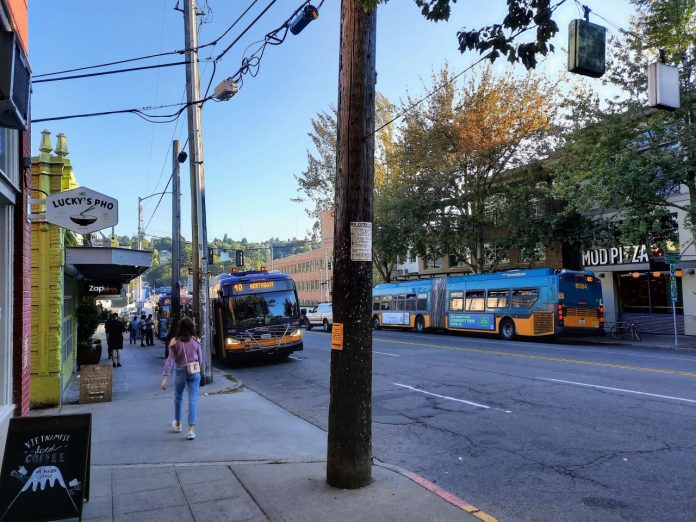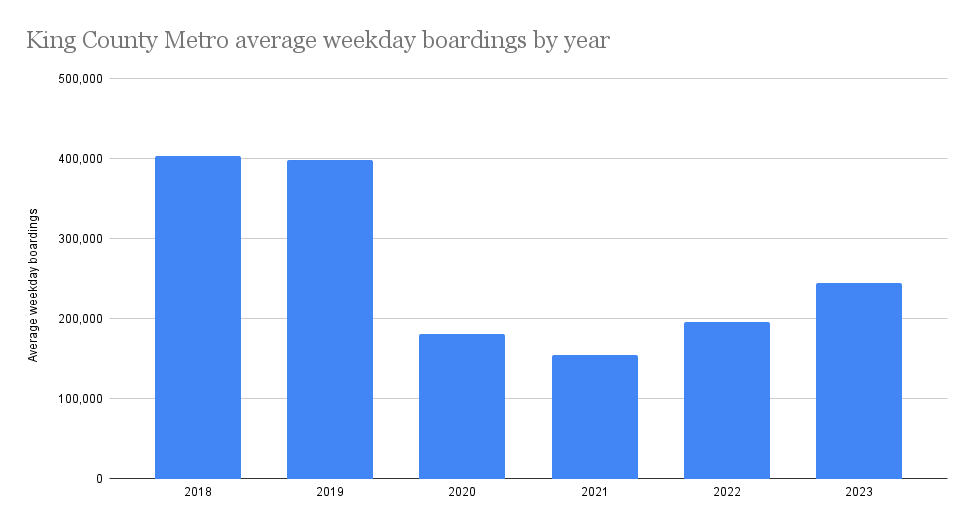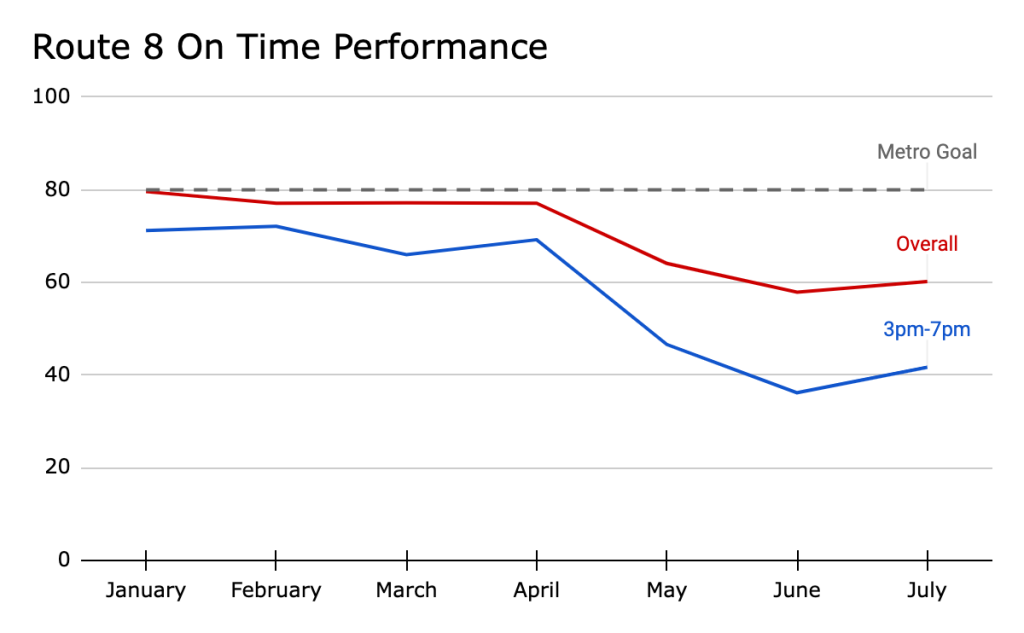
Buoyed by a bump in compensation in new contract, Metro is ramping up bus driver recruitment and hopes to grow service by fall 2024.
King County Metro is close to hitting its 99.7% service delivery target and has seen an uptick in recruiting mechanics and bus operators, according to Metro General Manager Michele Allison’s recent updates to King County Council. The September schedule change cut 4% of Metro’s bus service, but Allison credited it with restoring the agency’s service delivery reliability and staff morale.
That said, she stressed that the goal is to grow service levels rather than reliably offer less service.
“We still have some work to do, because we don’t want this to be our new normal. This is a base resetting for now so that we have that stability and customer confidence for the reintroduction of service when we are ready… We are not an agency that wants to reduce service. We are an agency that wants to grow, because we recognize that is what our riders want from us as well.”
How Metro is seeking to deploy service has also changed, with much more focus on weekend and midday service in response to pandemic-era trends. Weekend ridership is rebounding strongly and is at 80% of 2019 levels, while midday ridership is around 70%, but, in contrast, peak hour weekday ridership is just 44% of pre-pandemic levels, Allison said in her Tuesday briefing. Overall, ridership has reached about 65% of the 2019 mark.
Allison said staffing trends were positive for both drivers and mechanics. Still, staffing figures shared with The Urbanist show that operator staffing is well short of pre-pandemic levels and momentum relatively fledgling, with the overall trend line pretty flat.
Metro is seeking to boost the share of workers who are full-time in order to accommodate more all-day service, as opposed to older service profile that was highly focused on peak service, Allison said. That shift paired with the September service cuts has allowed the agency to be less reliant on overtime work.
“Over the span of the last few months, we’ve seen modest growth in our bus operator workforce capacity when looking at full-time equivalents (FTEs) thanks to the promotion of part-time to full-time operators,” Metro spokesperson Jeff Switzer said. “We continue to rely on high overtime rates to deliver service, but after our recent service change, we’ve also seen a 5% reduction in bus operator overtime, which is a good sign.”
Switzer noted the agency prefers to use working FTEs to measure workforce capacity “as it accounts for the difference in hours worked between full-time and part-time operators, factors in overtime, and other nuances in the workforce.”

New contract with bus drivers and mechanics boosts pay
Metro signed a new labor agreement with its bus operators who are represented by Amalgamated Transit Union (ATU) Local 587. On August 15, ATU member ratified the contract, which increased wages by about 17% over the life the three-year contract and boosted benefits for part-time operators. The inclusion of $2,500 retention bonus and a one-time $2,500 ratification signing bonus may also stem the pace of departures from Metro ranks. The offer of a $3,000 recruitment bonus to both operators and mechanics could help get more hires in the door.
ATU leaders were bullish about the prospect of a workforce rebound.
“These are opportunities that current transit workers deserve,” ATU 587 president Ken Price said in a statement. “And they will help us bring more workers into the workforce to meet the needs of our county.”
Metro boosted its class sizes for training new bus drivers from it previous mark of 25 per month to 60 per month by October, and aims to incrementally increase capacity to a target of 100 trainees per month by spring 2024. The agency also simplified its CDL certification test to remove some superfluous requirements that were tripping up applicants.
“To increase our training capacity, we’re increasing the frequency of classes and all of the resources needed to support that, including a new hiring process,” Switzer said. “We’ve also seen significant improvement in our mechanic hiring trends, including four months of month-over-month staffing increases; we have not seen a trend like this since before the pandemic.”
Recruiting more drivers
With the class sizes only hitting 60 this month, it’s still too early to begin reaping the benefits and seeing a full rebound from the hole Metro had dug for itself during the pandemic as it shed operators and bus service. However, the trend being in the right direction is progress at least.

County Councilmember Claudia Balducci noted that anecdotally she was noticing that ridership was rebounding on the routes she was using. This appears to be borne out in Metro’s ridership data as well. Balducci noted it would be important to get on a growth trajectory to serve that demand, and she asked for more specific metrics around recruitment to be shared with the council in the future.

Allison said if everything goes well with the recruiting plan, Metro expects to be able to add back some service in September 2024, with the agency still expecting to be in rebuild mode in the spring.
Late buses and Route 8 response
While missed trips are way down, issues with late buses remain stubbornly persistent.
After bottoming out at 75% in July, Metro’s on-time performance has trended up to 77% in September and October. Nonetheless, reliability and transit speed remains an issue on many routes due to congestion-related delays. By Metro’s definition, a bus is considered on-time if it is between one minute early and five minutes late.

Metro’s Route 8 has been the posterchild for late buses, and County Councilmember Jeanne Kohl-Welles noted she had heard plenty of complaints after a rider-led letter-writing campaign (which we covered in The Urbanist) asked Allison what the agency was doing to rectify that. Route 8’s on-time performance is only around 40% during afternoon peak hours.
County Councilmember Rod Dembowski said that adding bus lanes would be key to improving reliability, but that such corridor improvements would ultimately be up to the Seattle Department of Transportation (SDOT). Allison said she would follow up with councilmembers with more details on Route 8.
Kohl-Welles subsequently shared a joint response from Metro and SDOT with advocates who sent letters to her office.
“Two projects are underway to help improve reliability,” the agencies responded. “In the project budget, the upcoming Denny Way Paving Project scoped consolidation of additional bus stops to help with bunching and is expected to start construction as soon as 2024. SDOT and Metro recently began a partnership project to create a new bus pathway on Harrison and Mercer Streets to provide additional east-west bus service on less congested streets. That is a longer-term effort as that project is expected to be completed in 2028. Both agencies commit to continuing to look for solutions on Denny Way such as prioritizing moving more people and goods by funding investments meeting climate targets like bus priority, as recommended in the draft Seattle Transportation Plan and King County’s Strategic Climate Action Plan.”
The agencies summarized past actions they had taken seeking to improve Route 8 reliability, such as a few brief stretches of bus lanes in Uptown and in Denny Triangle. Ultimately, they admitted those interventions were not terribly effective.
“Despite investments, reliability on Denny Way continues to be a challenging problem to solve due to travel demand and major construction impacts,” they wrote. “SDOT and Metro are dedicated to working together to provide mobility and find ways to prioritize transit in the city of Seattle. SDOT and Metro will continue to discuss and review the potential for transit priority treatments along Denny Way, including extending the transit-only lane, to see if it is feasible in this unique transportation environment.”
Solving for service frequency and reliability still remains a complicated knot to untie given the challenges recruiting and dedicating enough street space to make key bus routes reliable. However, increasingly policymakers are acknowledging the problem and the path forward. Riders wait for them to forge ahead.
Doug Trumm is publisher of The Urbanist. An Urbanist writer since 2015, he dreams of pedestrian streets, bus lanes, and a mass-timber building spree to end our housing crisis. He graduated from the Evans School of Public Policy and Governance at the University of Washington in 2019. He lives in Seattle's Fremont neighborhood and loves to explore the city by foot and by bike.



